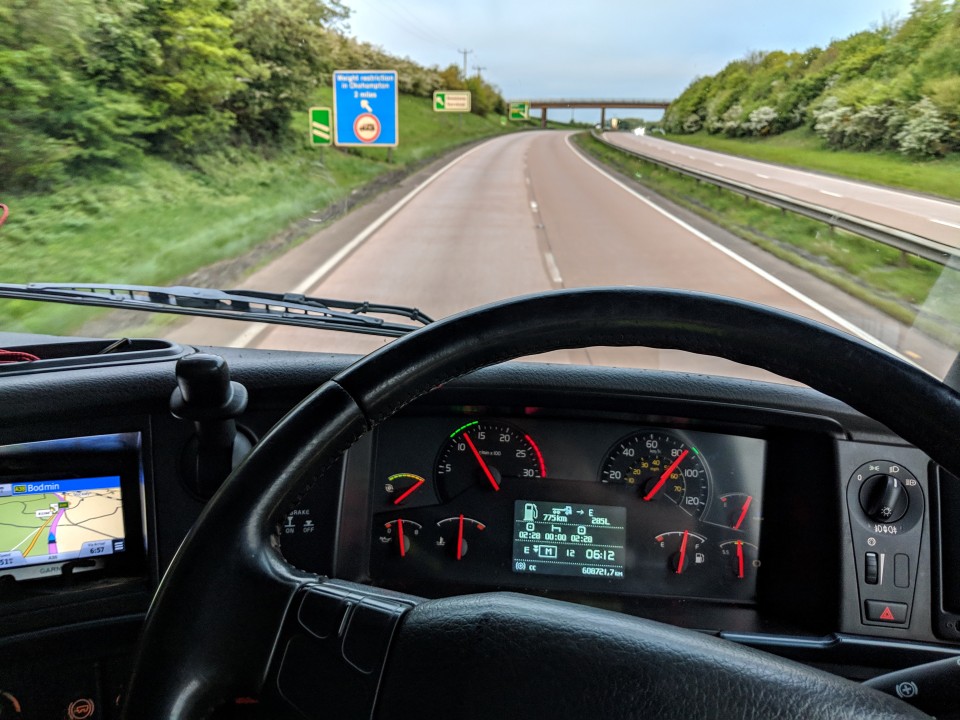
Susie Jones
Fahrtenschreiberregeln leicht gemacht
Erstellt: 01.08.2024
•
Aktualisiert: 08.08.2024
Die Welt der Fahrtenschreiberregeln kann selbst für den erfahrensten Lkw-Fahrer verwirrend sein. Ganz zu schweigen von denen, die neu in die Branche einsteigen. Wir wollen diese Verwirrung etwas aufklären.
Was ist ein Fahrtenschreiber und warum haben wir sie?
Laut Wörterbuch ist ein Fahrtenschreiber "ein Gerät, das in Fahrzeuge wie Lastwagen und Busse eingebaut wird, um Informationen aufzuzeichnen, z. B. wie schnell das Fahrzeug fährt, wie weit es fährt und wie viele Pausen der Fahrer einlegt."
Der Zweck eines Fahrtenschreibers besteht darin, die Übermüdung des Fahrers zu verhindern und sicherzustellen, dass sich Fahrer und Arbeitgeber an die Vorschriften halten. [Die Wohltätigkeitsorganisation Brake (https://www.brake.org.uk/get-involved/take-action/mybrake/knowledge-centre/driver-fatigue) berichtet, dass "vier von zehn müdigkeitsbedingten Unfällen von Fahrern eines Nutzfahrzeugs verursacht werden". Daher spielen die Fahrtenschreibervorschriften eine wichtige Rolle bei der Verringerung dieser Zahl.
Wann brauchen Sie einen Fahrtenschreiber?
Sie müssen einen Fahrtenschreiber einbauen, wenn Ihr Gesamtgewicht mehr als dreieinhalb Tonnen beträgt. Dabei ist es wichtig zu wissen, dass dies auch für das Ziehen eines Anhängers gilt. Es gibt ein paar Ausnahmen von dieser Regel:
Wenn Sie nur abseits öffentlicher Straßen fahren
Wenn das Fahrzeug von den Streitkräften, der Polizei oder der Feuerwehr gefahren wird
Wenn Sie ein gewerblicher Fuhrpark sind und Fahrzeuge mit einem Höchstgewicht von siebeneinhalb Tonnen einsetzen und Ihre Fahrt weniger als 100 km von Ihrem Betriebsstandort entfernt ist.
Wenn Sie Waren transportieren und Ihr Fahrzeug elektrisch betrieben wird
Wenn Sie Geräte oder Maschinen für den Fahrer transportieren und das Führen dieses Fahrzeugs nicht Ihre Haupttätigkeit ist.
Was sind die verschiedenen Arten von Fahrtenschreibern?
Es gibt drei verschiedene Arten von Fahrtenschreibern:
Analog: Sie wurden 1986 in Europa verbindlich eingeführt. Analoge Fahrtenschreiber verwenden Wachspapierblätter zur Aufzeichnung der Fahrerdaten. Die Fahrer geben die Daten manuell ein und stecken sie in ein Fahrtenschreibergerät.
Digital: Diese wurden 2006 eingeführt. Sie werden von mehr als einer Million Transportunternehmen und über sechs Millionen Berufskraftfahrern genutzt. Digitale Fahrtenschreiber zeichnen Fahrerdaten auf einem internen Speicher und einer Fahrerkarte auf.
Intelligent: Ab Juni 2019 verlangt die Europäische Union von den Unternehmen den Einsatz von intelligenten Fahrtenschreibern. Diese zeichnen automatisch den Standort des Fahrzeugs zu Beginn und am Ende jeder Fahrt auf. Außerdem liefern sie alle drei Stunden Updates
Was bedeuten die einzelnen Fahrtenschreibersymbole?
Sehen Sie sich unser Video an, in dem jedes Fahrtenschreibersymbol erklärt wird.
Pausenregeln
Im Interesse der Sicherheit des Lkw-Fahrers und aller anderen Verkehrsteilnehmer müssen die Pausenregeln eingehalten werden. Wir haben die wichtigsten Punkte aufgeschlüsselt.
Lenkzeit:
- Darf nicht länger als viereinhalb Stunden vor einer Pause sein
Pausen:
- Müssen mindestens 45 Minuten betragen, es sei denn, der Fahrer legt eine Ruhezeit ein
Ruhezeit:
- Während der Ruhezeit kann nicht gefahren oder gearbeitet werden.
Aufteilung der Pausen:
Eine volle 45-Minuten-Pause kann durch eine 15-Minuten-Pause, gefolgt von einer 30-Minuten-Pause, aufgeteilt werden.
Die Unterbrechungen müssen auf die viereinhalbstündige Lenkzeit verteilt werden.
Nach den EU-Vorschriften muss bei geteilten Pausen die zweite Pause mindestens 30 Minuten betragen.

Tageslimit
Die Tageslenkzeitbeschränkung bezieht sich auf die maximale Lenkzeit an einem Tag. Neun Stunden sind die Höchstgrenze, die jedoch auf 10 Stunden erhöht werden kann. Allerdings kann dies nicht mehr als zweimal in einer festen Woche geschehen. Die tägliche Lenkzeit kann definiert werden als:
Die kumulierte Gesamtlenkzeit zwischen dem Ende einer täglichen Ruhezeit und dem Beginn der folgenden täglichen Ruhezeit
Die kumulierte Gesamtlenkzeit zwischen einer täglichen und einer wöchentlichen Ruhezeit. .
Wöchentliches und zweiwöchentliches Tempolimit
Die Fahrer müssen darauf achten, dass sie die wöchentlichen und zweiwöchentlichen Höchstgrenzen nicht überschreiten.
Die wöchentliche Höchstlenkzeit beträgt 56 Stunden (gilt für eine feste Woche)
Eine feste Woche beginnt um 00.00 Uhr und endet um 24.00 Uhr des folgenden Sonntags
Eine zweiwöchige Lenkzeitbeschränkung beträgt 90 Stunden.
Tägliche Ruhezeit
Außerdem muss eine tägliche Ruhezeit eingehalten werden.
Der Fahrer muss eine ununterbrochene Ruhezeit von 11 Stunden einlegen. Diese kann auf neun Stunden verkürzt werden
Diese Reduzierung kann nur bis zu dreimal zwischen den wöchentlichen Ruhezeiten erfolgen.
Die Ruhezeit muss innerhalb von 24 Stunden nach Ende der letzten täglichen oder wöchentlichen Ruhezeit beendet sein.
Die tägliche Ruhezeit kann im Fahrzeug verbracht werden; es sind jedoch geeignete Schlafmöglichkeiten erforderlich. Wenn diese nicht vorhanden sind, muss der Fahrer eine Unterkunft finden. Auf unserer Seite Standorte erfahren Sie, welche Raststätten diesen Service anbieten.
Wöchentliche Ruhezeit
Wöchentliche Ruhezeiten müssen spätestens am Ende von sechs aufeinanderfolgenden 24-Stunden-Zeiträumen ab dem Ende der letzten wöchentlichen Ruhezeit genommen werden.
Die Fahrer müssen mindestens 45 Stunden Ruhezeit einlegen.
Sie können eine reduzierte wöchentliche Ruhezeit von mindestens 24 Stunden einlegen.
Die reduzierte wöchentliche Ruhezeit muss in einem Block ausgeglichen werden, und zwar mindestens neun Stunden vor Ende der dritten Woche.
Zwar kann eine reduzierte Ruhezeit in Anspruch genommen werden, doch ist zu beachten, dass in zwei aufeinanderfolgenden Wochen, in denen eine reduzierte Ruhezeit in Anspruch genommen wurde, eine 45 Stunden lang sein muss.

Mehrfachbesetzung
Einige Fahrer können einen weiteren Fahrer an Bord nehmen. Zu den Vorteilen gehören eine höhere Produktivität, mehr zurückgelegte Kilometer und eine längere Fahrzeit.
Beide Fahrer müssen eine tägliche Ruhezeit von neun Stunden einlegen.
Diese tägliche Ruhezeit muss innerhalb von 30 Stunden und nicht innerhalb von 24 Stunden genommen werden.
In der ersten Stunde des Mehrfahrerbetriebs ist kein weiterer Fahrer erforderlich. Nach einer Stunde wird er obligatorisch.
Fährüberfahrten oder Zugfahrten
Wie bereits erwähnt, muss die regelmäßige tägliche Ruhezeit eines Fahrers 11 Stunden ununterbrochen betragen, allerdings gibt es einige Ausnahmen von dieser Regel. Sofern das Fahrzeug vom Fahrer begleitet wird, kann die tägliche Ruhezeit zweimal unterbrochen werden, darf aber insgesamt eine Stunde nicht überschreiten. Zum Beispiel beim Ein- und Aussteigen auf Fähren und in Zügen.
Wird die regelmäßige tägliche Ruhezeit auf diese Weise unterbrochen, so muss die kumulierte Ruhezeit mindestens 11 Stunden betragen oder 12 Stunden, wenn sie aufgeteilt wird.
Was ist die Ein-Minuten-Regelung für Fahrtenschreiber?
Die Ein-Minuten-Regel ist im Oktober 2011 in Kraft getreten. Sie bezieht sich auf ältere Rechtsvorschriften, in denen festgelegt war, dass eine Minute, in der mindestens fünf Sekunden gefahren wurde, als Lenkzeit aufgezeichnet werden musste. Die EU änderte diese Rechtsvorschriften jedoch dahingehend, dass die längste ununterbrochene Tätigkeit innerhalb einer Minute für diese spezielle Tätigkeit aufgezeichnet wird.
Was würde passieren, wenn ich mich nicht an die Fahrtenschreiberregeln halte?
Die Nichteinhaltung der Fahrtenschreibervorschriften kann zu Geld- und manchmal auch zu Freiheitsstrafen führen. Im Allgemeinen hängt die Strafe von der Schwere des Verstoßes ab. Die meisten Verstöße gegen den Fahrtenschreiber werden mit festen Geldstrafen geahndet. Die Fahrer haben bis zu 28 Tage Zeit, um die Bußgeldbescheide zu prüfen.
Im Vereinigten Königreich gibt es zwei Arten von Geldstrafen und Bußgeldern.
Bußgeld der Stufe vier: Die Obergrenze liegt bei 2.500 £; diese Obergrenze gilt für jedes einzelne Tacho-Bußgeld. In Fällen mit mehreren Verstößen der Stufe vier kann jedoch eine Höchststrafe pro Verstoß verhängt werden.
Bußgeld der Stufe fünf: Die Obergrenze liegt bei 5.000 Pfund, doch wie bei den Bußgeldern der Stufe vier kann auch hier bei mehreren Verstößen die Höchststrafe verhängt werden.
Die Vorschriften für Fahrtenschreiber sind mitunter schwer zu verstehen. Werden sie jedoch nicht beachtet, kann dies zu Sicherheitsproblemen und möglichen Geldbußen führen. Wenn Flotten und Fahrer die Regeln verstehen und befolgen, können sie ihre Fahrzeuge sicher und legal betreiben. Es ist wichtig zu wissen, dass die Regeln und Vorschriften für Fahrtenschreiber von Land zu Land unterschiedlich sein können.



